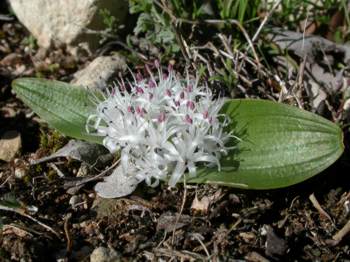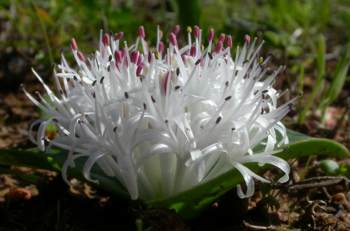Lachenalia pygmaea
Lachenalia pygmaea (Jacq.) G.D.Duncan
Family: Hyacinthaceae
Common names: none recorded; suggested name: pygmy hyacinth
Introduction
This tiny lachenalia with pale, almond-scented flowers belongs to subgenus Polyxena and makes a delightful pot plant.

Description
Description
It consists of a single, white, fleshy bulb about 12-25mm in diameter, with fine white adventitious roots, and two spreading, broadly lanceolate leaves, 45-80×15-30mm, with distinctive grooves on the upper surface. Unlike certain Lachenalia species, L. pygmaea does not possess any bumps or pustules on the upper surface of the leaf. The leaf is leathery and usually bright green. Leaves will start to emerge a few weeks after the first rains in autumn, and wither naturally in late spring/early summer.
The inflorescence, in the form of a corymb or cluster of flowers nestled between the leaves, reaches only about 30mm tall. Flowers are white, or in certain forms bright mauve, with a strong almond scent. Flowers are erect, tubular, ±30mm long, and flaring to ±25mm across, with strongly reflexed tepals.

Flowering period, as with other members of the subgenus Polyxena, is early in the growing season. For this species it is from April to June, peaking in May. The fruits are small, papery capsules that ripen a month or two after flowering to release small matte black seeds.
Conservation Status
Status
This species is currently not recognised as being threatened; however, it has lost more than 60% of its habitat in the last 70 years. Certain local forms of this species may be extinct, and many only remain in very small and fragmented populations on roadsides and unploughed corners of farmland.
Distribution and habitat
Distribution description
Lachenalia pygmaea exists as two distinct and disjunct populations with an approximately 400km gap between them: in the Northern Cape from Kamieskroon to Garies including the Kamiesberg, and in the Southern Cape from the Anysberg to De Hoop on the south coast. It is found in a variety of fynbos habitats: shallow grit on granite rock sheets in Namaqualand, and in the south on deep sandy soils, calcareous outcrops and in clay slopes.

Derivation of name and historical aspects
History
The specific name pygmaea refers to its diminutive size. This species formerly belonged to the genus Polyxena, a distinct group of six species of dwarf hyacinths always suspected to have been closely allied to Lachenalia . In his 2012 revision of the genus Lachenalia , Graham Duncan, Chief Botanical Horticulturist at Kirstenbosch National Botanical Garden, showed with DNA evidence that Polyxena species should in fact be nested within Lachenalia. The group is still recognised as subgenus Polyxena.
Lachenalia pygmaea is most closely related to L. ensifolia but differs by its more slender and longer perianth tube and its matte seeds, L. ensifolia having glossy seeds.
Ecology
Ecology
Flowers of Lachenalia pygmaea are sweetly almond-scented and are predominantly pollinated by honeybees ( Apis mellifera ) and the painted lady butterfly ( Vanessa cardui ). Seeds are released from the fruits in a salt shaker fashion. The flowering structure elongates rapidly as the fruit forms, and soon dries, forming dry papery capsules which are caught by the wind, shaking the seeds on to the ground around the mother plant. It eventually breaks off and tumbles along the ground, dispersing the rest of the seeds as it rolls.

Uses
Use
There are no known cultural uses of this plant.
Growing Lachenalia pygmaea
Grow
Lachenalias are often regarded as one of the most rewarding groups of Cape winter-growing bulbs to cultivate. One of their virtues is their vast array of flower colours appearing in practically every colour of the rainbow.
Lachenalia pygmaea is very easy to grow and very rewarding as a pot subject. The soil medium should be fairly well-drained and consist of about half coarse washed sand and half finely sieved compost. This should be used to fill the lower two-thirds of the pot. The upper third should be pure sand, with no loam or compost, into which the bulbs are planted. This layer is thus well-drained and stays relatively dry, preventing the bulbs from rotting if they should get too wet, while the roots can safely penetrate the richer, moister organic medium below. They should be kept in full sun and will grow very happily outside during the winter months, providing the temperature does not drop below freezing. In summer the bulbs should be kept dry, preferably in a cool position out of direct sunlight. One can either lift the bulbs and store them in paper bags, or store them in their pots. They respond well to being repotted every 2–3 years with fresh soil medium, however, replenishment from seed is advisable as they are not particularly long lived.
They are easily propagated from leaf cuttings, which can be removed from the plant by slicing them at the base of the leaf blade. These leaves are then half buried in a very sandy/gritty medium and left in a cool place out of direct sunlight but with a fair degree of ambient humidity. The soil should be kept on the dry side to prevent the leaves from rotting, while the humidity can be quite high – humid air and dry soil are essential. A cold frame setup is ideal. Within a few months, small bulbils will appear along the cut edge at the base of the leaf. Eventually the leaf will wither, but the bulbils can be planted like normal bulbs the following season. Flowering will take 1–2 years.
They are also easily raised from seeds, which should be sown in autumn in a similar medium used for cultivation with a thin layer of soil (approximately 2–3 mm) placed over the seeds. Water them gently but regularly in the first few weeks. The seedlings should germinate within about 2–3 weeks. Flowering will take 2–3 years.
They don't have many pests apart from snails and caterpillars (which can be removed by hand) and mealy bug which should be treated with a systemic pesticide. A rust fungus can be problematic and appears as orange blotches on the leaves, often developing where a leaf has been damaged by hail, for example. This is easily prevented (which is preferable) or treated, both with common fungicides.
Not much fertilising is required for these bulbs as they are generally not very demanding, but they will respond well to small doses of a diluted, low-nitrogen liquid fertiliser.
References
- Duncan, G.D. 2012. The Genus Lachenalia. Kew Publishing, Kew.
- Manning, J., Goldblatt, P. & Snijman, D. 2002. The colour Encyclopedia of Cape Bulbs . Timber Press, Portland.
- Raimondo, D., Von Staden, L., Foden, W., Victor, J.E., Helme, N.A., Turner, R.C., Kamundi, D.A. & Manyama, P.A. 2009. Red List of South African plants. Strelitzia 25. South African National Biodiversity Institute, Pretoria.
Credits
Adam Harrower
Kirstenbosch National Botanical Garden
June 2014
Plant Attributes:
Plant Type: Bulb
SA Distribution: Northern Cape, Western Cape
Soil type:
Flowering season: Late Summer, Autumn
PH:
Flower colour: White, Mauve/Lilac
Aspect:
Gardening skill:
Special Features:
Horticultural zones








Rate this article
Article well written and informative
Rate this plant
Is this an interesting plant?
User Comments
Mary Gillett, South Africa
October 03, 2020 at 9:53 PMI have a group of Lachenalia in a rock pocket that have flowered brilliantly for 20 years ... this year 2020... hardly any and when I dug out the pocket they had been destroyed by a lilly borer. All the literature claims they have no serious pests except snails or worms .... sadly like the Aggie, this no longer holds true
Login to add your Comment
Back to topNot registered yet? Click here to register.